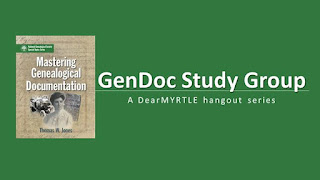Mastering Genealogical Documentation Study Group
Chapter Two – Noncitation Aspects of Genealogical
Documentation
Marceline Beem
Reference:
Jones, Thomas W. "Noncitation Aspects of Genealogical
Documentation." In Mastering
Genealogical Documentation, 11-24. Arlington, VA: National Genealogical
Society, 2017.
One of my weaknesses in my genealogical writing is linking
pieces of evidence together, or fully connecting the dots. It’s not that I
don’t have the evidence needed to do that – it’s just that I forget my reader
does not know everything that I know, so I sometimes forget to give a full
explanation that will make sense to my audience. This is especially true in writing footnotes
with more than one citation, so I appreciated the section of this week's reading that discussed this issue.
One recent example of this is found in my proof argument
assignment for ProGen. I wrote one section that discussed indirect evidence
from burials at Holy Cross Cemetery in Colma, California. Below are screen
shots which show part of the discussion and the corresponding endnotes:
 |
| Figure 1. Excerpt of discussion of Haley family burials at Holy Cross Cemetery |
 |
| Figure 2. Corresponding Endnotes for Figure 1. |
One of the questions posed to me during the peer review was "How do you know Charlotte Anderson was Lydia's daughter?" I thought covered that in the footnote, but oops - and a very big oops - I did not include enough explanatory text to show the relationship. My final draft changed the endnotes to footnotes (that's a story for another day), and the footnote for for this sentence was revised:
 |
| Figure 3. Revised Footnote for Figure 1. |
Notice that in the revised version, I don't just cite the coroner's records, but I state what the coroner reported that supports my assertion that Lydia was buried in the same plot as her daughter. This helps tie the burials and coroner's record together, and strengthens the entire proof argument.
My takeaway is that when we craft citations, we need to not only answer give the pertinent details of the source's author, publication information, and other relevant details, but sometimes we also need to write an explanation so that the reader fully understands why we included the source and how it supports our conclusions.


This is a really good reminder. I often forget to connect the dots, too. You live with the research for so long it just seems evident.
ReplyDeleteYes, that's exactly my problem! Glad to hear I'm not the only one!
Delete